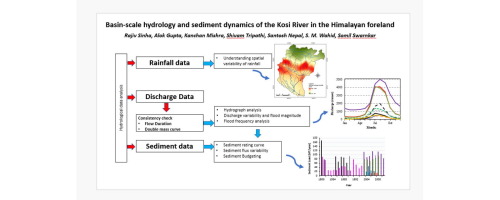当前位置:
X-MOL 学术
›
J. Hydrol.
›
论文详情
Our official English website, www.x-mol.net, welcomes your
feedback! (Note: you will need to create a separate account there.)
Basin-scale hydrology and sediment dynamics of the Kosi River in the Himalayan foreland
Journal of Hydrology ( IF 5.9 ) Pub Date : 2019-03-01 , DOI: 10.1016/j.jhydrol.2018.12.051 Rajiv Sinha , Alok Gupta , Kanchan Mishra , Shivam Tripathi , Santosh Nepal , S.M. Wahid , Somil Swarnkar
Journal of Hydrology ( IF 5.9 ) Pub Date : 2019-03-01 , DOI: 10.1016/j.jhydrol.2018.12.051 Rajiv Sinha , Alok Gupta , Kanchan Mishra , Shivam Tripathi , Santosh Nepal , S.M. Wahid , Somil Swarnkar

|
Abstract Hydrological and sediment transport characteristics for the Kosi basin, which covers parts of Nepal and India, were analysed to understand the spatiotemporal variability of the hydrology and sediment dynamics of the Kosi basin and its implications for flood hazard and sediment dynamics. The study revealed that ∼56% of the discharge at Chatara (where all major tributaries of the Kosi meet) is contributed from the western part of the basin even though this constitutes only 34% of the total basin area. In contrast, the central and eastern parts of the basin constitute 57% and 8% of the basin area but contribute ∼38% and ∼16% of the discharge at Chatara, respectively. The contribution of sediment load at Chatara from the different tributaries of the Kosi River also shows a similar pattern. Of a total of ∼100 million tonnes of the annual sediment load at Chatara, ∼56% is transported from four tributaries: the Indrawati, Bhote Kosi, Tama Kosi (all draining from the west), and Tamor. The remaining ∼44% is transported by other tributaries upstream of Chatara, the most important being the Arun, Dudh Kosi, and Sun Kosi. Sediment budgeting in this study, based on annual sediment load data, suggested that ∼20 million tonnes of sediments are deposited between Chatara and Birpur annually. This study also found that ∼53 million tonnes of sediments are being accommodated between Birpur and Baltara annually. Sediment dynamics in the Kosi basin emerges as the most important river management issue, and this is closely linked to channel instability and frequent flooding in the alluvial plains.
中文翻译:

喜马拉雅前陆科西河流域尺度水文和沉积动力学
摘要 对覆盖尼泊尔和印度部分地区的 Kosi 盆地的水文和泥沙输送特征进行了分析,以了解 Kosi 盆地水文和沉积动力学的时空变异性及其对洪水灾害和沉积动力学的影响。研究表明,Chatara(科西河的所有主要支流汇合处)约 56% 的流量来自盆地西部,尽管这仅占盆地总面积的 34%。相比之下,盆地的中部和东部分别占盆地面积的 57% 和 8%,但分别占查塔拉流量的约 38% 和约 16%。来自 Kosi 河不同支流的 Chatara 沉积物负荷的贡献也显示出类似的模式。在 Chatara 每年约 1 亿吨的沉积物负荷中,约 56% 来自四个支流:Indrawati、Bhote Kosi、Tama Kosi(均从西部排水)和 Tamor。剩余的约 44% 由 Chatara 上游的其他支流运输,最重要的是 Arun、Dudh Kosi 和 Sun Kosi。本研究中的沉积物预算,基于年度沉积物负荷数据,表明每年约有 2000 万吨沉积物沉积在 Chatara 和 Birpur 之间。这项研究还发现,每年约有 5300 万吨沉积物被容纳在 Birpur 和 Baltara 之间。科西盆地的沉积物动态成为最重要的河流管理问题,这与冲积平原的河道不稳定和频繁的洪水密切相关。约 56% 来自四个支流:Indrawati、Bhote Kosi、Tama Kosi(均从西部流出)和 Tamor。剩余的约 44% 由 Chatara 上游的其他支流运输,最重要的是 Arun、Dudh Kosi 和 Sun Kosi。本研究中的沉积物预算,基于年度沉积物负荷数据,表明每年约有 2000 万吨沉积物沉积在 Chatara 和 Birpur 之间。这项研究还发现,每年约有 5300 万吨沉积物被容纳在 Birpur 和 Baltara 之间。科西盆地的沉积物动态成为最重要的河流管理问题,这与冲积平原的河道不稳定和频繁的洪水密切相关。约 56% 来自四个支流:Indrawati、Bhote Kosi、Tama Kosi(均从西部流出)和 Tamor。剩余的约 44% 由 Chatara 上游的其他支流运输,最重要的是 Arun、Dudh Kosi 和 Sun Kosi。本研究中的沉积物预算,基于年度沉积物负荷数据,表明每年约有 2000 万吨沉积物沉积在 Chatara 和 Birpur 之间。这项研究还发现,每年约有 5300 万吨沉积物被容纳在 Birpur 和 Baltara 之间。科西盆地的沉积物动态成为最重要的河流管理问题,这与冲积平原的河道不稳定和频繁的洪水密切相关。剩余的约 44% 由 Chatara 上游的其他支流运输,最重要的是 Arun、Dudh Kosi 和 Sun Kosi。本研究中的沉积物预算,基于年度沉积物负荷数据,表明每年约有 2000 万吨沉积物沉积在 Chatara 和 Birpur 之间。这项研究还发现,每年约有 5300 万吨沉积物被容纳在 Birpur 和 Baltara 之间。科西盆地的沉积物动态成为最重要的河流管理问题,这与冲积平原的河道不稳定和频繁的洪水密切相关。剩余的约 44% 由 Chatara 上游的其他支流运输,最重要的是 Arun、Dudh Kosi 和 Sun Kosi。本研究中的沉积物预算,基于年度沉积物负荷数据,表明每年约有 2000 万吨沉积物沉积在 Chatara 和 Birpur 之间。这项研究还发现,每年约有 5300 万吨沉积物被容纳在 Birpur 和 Baltara 之间。科西盆地的沉积物动态成为最重要的河流管理问题,这与冲积平原的河道不稳定和频繁的洪水密切相关。表明每年约有 2000 万吨沉积物沉积在 Chatara 和 Birpur 之间。这项研究还发现,每年约有 5300 万吨沉积物被容纳在 Birpur 和 Baltara 之间。科西盆地的沉积物动态成为最重要的河流管理问题,这与冲积平原的河道不稳定和频繁的洪水密切相关。表明每年约有 2000 万吨沉积物沉积在 Chatara 和 Birpur 之间。这项研究还发现,每年约有 5300 万吨沉积物被容纳在 Birpur 和 Baltara 之间。科西盆地的沉积物动态成为最重要的河流管理问题,这与冲积平原的河道不稳定和频繁的洪水密切相关。
更新日期:2019-03-01
中文翻译:

喜马拉雅前陆科西河流域尺度水文和沉积动力学
摘要 对覆盖尼泊尔和印度部分地区的 Kosi 盆地的水文和泥沙输送特征进行了分析,以了解 Kosi 盆地水文和沉积动力学的时空变异性及其对洪水灾害和沉积动力学的影响。研究表明,Chatara(科西河的所有主要支流汇合处)约 56% 的流量来自盆地西部,尽管这仅占盆地总面积的 34%。相比之下,盆地的中部和东部分别占盆地面积的 57% 和 8%,但分别占查塔拉流量的约 38% 和约 16%。来自 Kosi 河不同支流的 Chatara 沉积物负荷的贡献也显示出类似的模式。在 Chatara 每年约 1 亿吨的沉积物负荷中,约 56% 来自四个支流:Indrawati、Bhote Kosi、Tama Kosi(均从西部排水)和 Tamor。剩余的约 44% 由 Chatara 上游的其他支流运输,最重要的是 Arun、Dudh Kosi 和 Sun Kosi。本研究中的沉积物预算,基于年度沉积物负荷数据,表明每年约有 2000 万吨沉积物沉积在 Chatara 和 Birpur 之间。这项研究还发现,每年约有 5300 万吨沉积物被容纳在 Birpur 和 Baltara 之间。科西盆地的沉积物动态成为最重要的河流管理问题,这与冲积平原的河道不稳定和频繁的洪水密切相关。约 56% 来自四个支流:Indrawati、Bhote Kosi、Tama Kosi(均从西部流出)和 Tamor。剩余的约 44% 由 Chatara 上游的其他支流运输,最重要的是 Arun、Dudh Kosi 和 Sun Kosi。本研究中的沉积物预算,基于年度沉积物负荷数据,表明每年约有 2000 万吨沉积物沉积在 Chatara 和 Birpur 之间。这项研究还发现,每年约有 5300 万吨沉积物被容纳在 Birpur 和 Baltara 之间。科西盆地的沉积物动态成为最重要的河流管理问题,这与冲积平原的河道不稳定和频繁的洪水密切相关。约 56% 来自四个支流:Indrawati、Bhote Kosi、Tama Kosi(均从西部流出)和 Tamor。剩余的约 44% 由 Chatara 上游的其他支流运输,最重要的是 Arun、Dudh Kosi 和 Sun Kosi。本研究中的沉积物预算,基于年度沉积物负荷数据,表明每年约有 2000 万吨沉积物沉积在 Chatara 和 Birpur 之间。这项研究还发现,每年约有 5300 万吨沉积物被容纳在 Birpur 和 Baltara 之间。科西盆地的沉积物动态成为最重要的河流管理问题,这与冲积平原的河道不稳定和频繁的洪水密切相关。剩余的约 44% 由 Chatara 上游的其他支流运输,最重要的是 Arun、Dudh Kosi 和 Sun Kosi。本研究中的沉积物预算,基于年度沉积物负荷数据,表明每年约有 2000 万吨沉积物沉积在 Chatara 和 Birpur 之间。这项研究还发现,每年约有 5300 万吨沉积物被容纳在 Birpur 和 Baltara 之间。科西盆地的沉积物动态成为最重要的河流管理问题,这与冲积平原的河道不稳定和频繁的洪水密切相关。剩余的约 44% 由 Chatara 上游的其他支流运输,最重要的是 Arun、Dudh Kosi 和 Sun Kosi。本研究中的沉积物预算,基于年度沉积物负荷数据,表明每年约有 2000 万吨沉积物沉积在 Chatara 和 Birpur 之间。这项研究还发现,每年约有 5300 万吨沉积物被容纳在 Birpur 和 Baltara 之间。科西盆地的沉积物动态成为最重要的河流管理问题,这与冲积平原的河道不稳定和频繁的洪水密切相关。表明每年约有 2000 万吨沉积物沉积在 Chatara 和 Birpur 之间。这项研究还发现,每年约有 5300 万吨沉积物被容纳在 Birpur 和 Baltara 之间。科西盆地的沉积物动态成为最重要的河流管理问题,这与冲积平原的河道不稳定和频繁的洪水密切相关。表明每年约有 2000 万吨沉积物沉积在 Chatara 和 Birpur 之间。这项研究还发现,每年约有 5300 万吨沉积物被容纳在 Birpur 和 Baltara 之间。科西盆地的沉积物动态成为最重要的河流管理问题,这与冲积平原的河道不稳定和频繁的洪水密切相关。











































 京公网安备 11010802027423号
京公网安备 11010802027423号